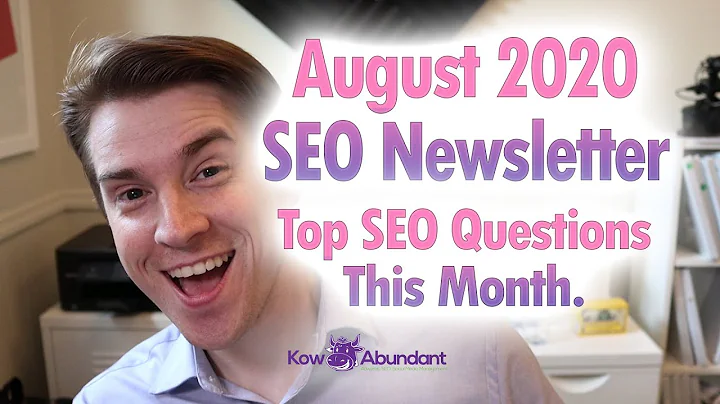Unlocking the Power of Programmatic SEO for Small Businesses
Table of Contents:
- Introduction
- What is Programmatic SEO?
- The Value of Programmatic SEO
- Implementing Programmatic SEO in Small Businesses
- Pros and Cons of Programmatic SEO
- The Process of Implementing Programmatic SEO
- Ranking and Indexing with Programmatic SEO
- The Importance of Strategy in Programmatic SEO
- Potential Risks and Downsides of Programmatic SEO
- Conclusion
🔍 Introduction
In this article, we will explore the concept of programmatic SEO and how it can be implemented in small businesses. Programmatic SEO refers to the practice of creating thousands or millions of unique landing pages by using a template and data sources. We will discuss the value of programmatic SEO, the process of implementing it, and the potential risks and downsides to consider. By understanding these factors, business owners can make an informed decision on whether to utilize programmatic SEO in their marketing strategy.
🔍 What is Programmatic SEO?
Programmatic SEO involves using a data source and a template page to generate numerous landing pages with unique SEO elements. This allows for the scaling of content in a cost-effective and efficient manner. Unlike traditional SEO practices that focus on targeting highly competitive keywords, programmatic SEO targets long-tail keywords with high intent and lower competition. It automates the creation of landing pages based on various variables, such as location, industry, or specific use cases, to target niche markets effectively.
🔍 The Value of Programmatic SEO
Programmatic SEO offers several benefits for businesses. First, it enables the creation of a large number of landing pages that are hyper-specific to different search queries and user intent. This increases the chances of ranking for long-tail keywords and attracting highly relevant organic traffic. Second, programmatic SEO allows for efficient scaling of content creation, reducing the time and effort required to generate a large volume of landing pages manually. This makes it particularly valuable for businesses operating in niche markets or targeting specific industries. Finally, programmatic SEO facilitates A/B testing and quick updates, making it easier to adapt and optimize landing pages for better performance.
🔍 Implementing Programmatic SEO in Small Businesses
Small businesses can leverage programmatic SEO to improve their online visibility and attract targeted organic traffic. By identifying their target audience, conducting keyword research, and developing a strategy to target long-tail keywords, small businesses can create landing pages that cater to the specific needs and interests of their potential customers. Implementing programmatic SEO requires a combination of technical skills, data aggregation, and creative content generation. Utilizing no-code tools like WhaleSync can simplify the implementation process and make it more accessible for small businesses.
🔍 Pros and Cons of Programmatic SEO
Pros:
- Scalability: Programmatic SEO allows for the creation of a large volume of landing pages in a cost-effective and efficient manner.
- Hyper-specific targeting: By targeting long-tail keywords and niche market segments, programmatic SEO increases the chances of attracting highly relevant organic traffic.
- Quick updates and A/B testing: Programmatic SEO enables rapid updates and easy A/B testing, facilitating optimization for better performance.
Cons:
- Lack of personalization: Programmatic SEO may result in less personalized content compared to manually created pages, potentially affecting the user experience.
- Risk of low-quality content: Depending on the data sources and AI prompts used, programmatic SEO pages can be at risk of generating low-quality content that may not meet user intent or provide sufficient value.
🔍 The Process of Implementing Programmatic SEO
Implementing programmatic SEO involves several steps. First, businesses need to identify their target audience and conduct comprehensive keyword research to determine the long-tail keywords they will target. Next, they should define the static elements of their landing pages, such as the value proposition and unique selling points. Additionally, businesses need to consider the dynamic elements, such as AI-generated text, metadata, headings, and case studies, that will populate the landing pages. Creating a dynamic template that aligns with the brand's visual identity is essential. Once the template is ready, businesses can start generating a significant number of landing pages, gradually increasing the volume over time. Indexing and ranking these pages may require manual intervention, such as submitting them to Google Search Console for indexing.
🔍 Ranking and Indexing with Programmatic SEO
Ranking and indexing with programmatic SEO follow similar principles to traditional SEO practices. Google will crawl and index the pages based on their relevance, quality, and user experience factors. Although programmatic SEO may enable the creation of a large number of landing pages, it is crucial to ensure that they offer valuable and unique content. The use of no-code tools like WhaleSync can help manage and update the pages effectively. It is advisable to monitor the performance of the landing pages, make necessary updates, and track their rankings to maintain and improve their visibility on search engine result pages.
🔍 The Importance of Strategy in Programmatic SEO
A well-defined strategy is critical for the successful implementation of programmatic SEO. Instead of randomly targeting a vast number of keywords, businesses should align their programmatic SEO efforts with their overall marketing objectives. Choosing the right mix of long-tail keywords, understanding the user intent behind each keyword, and structuring the landing pages accordingly is crucial. Having a strategy in place ensures that the generated landing pages are relevant, valuable, and aligned with the business's goals.
🔍 Potential Risks and Downsides of Programmatic SEO
The main risk of programmatic SEO lies in the lack of strategic planning and implementation. Without a clear strategy, businesses may create landing pages that do not adequately address user intent or provide value. This can result in wasted time and resources. Additionally, the use of AI prompts and generative text carries the risk of generating low-quality or irrelevant content. It is essential to regularly review and optimize the generated content to ensure it aligns with user intent and provides a positive user experience.
🔍 Conclusion
Programmatic SEO offers small businesses a cost-effective and efficient way to create a large number of highly targeted landing pages. By utilizing data sources, templates, and AI-generated content, businesses can reach niche markets and rank for long-tail keywords with high intent. While programmatic SEO presents unique opportunities, it also requires strategic planning, continuous monitoring, and optimization. By understanding the value, process, and potential risks associated with programmatic SEO, small businesses can make informed decisions about integrating it into their marketing strategies.
Resource:







